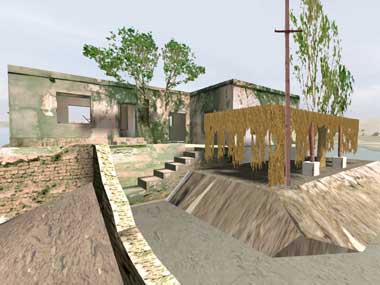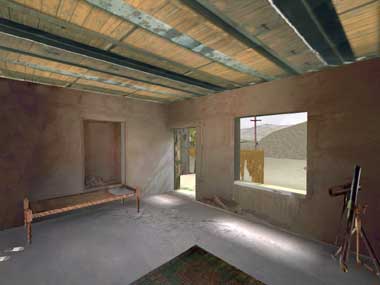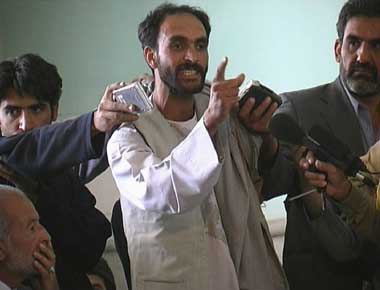Critics of contemporary art often complain that art has become irrelevant or too esoteric to be appreciated, but the very title of Ben Langlands and Nikki Bell’s installation proclaims its political engagment with world events.
The House of Osama bin Laden , currently showing at IMMA, is the result of a two-week visit to Afghanistan in October 2002. The project was commissioned by the Imperial War Museum in London, Langlands and Bell’s brief being to record their responses to the state of the war-torn country. It is the second such exhibition to be displayed at IMMA; the first was Belfast-born Paul Seawright’s hidden, which consisted of ten photographs investigating the landscapes of Afghanistan that had been contaminated with mines.
Due to the name of the infamous and elusive terrorist in the title of the exhibition, The House of Osama bin Laden is sure to draw in the public. The possibiity of catching a glimpse into the home and thus the intimate private life of the most wanted man in the world is an intriguing concept. In a sense, Osama bin Laden could be seen as a celebrity of sorts, with the exhibition preying upon our voyeuristic tendencies.
 Langlands & Bell, T he House of Osama bin Laden, Titles of screen shots from interactive digital animation, April 2003, In collaboration with V/SpaceLAB, Courtesy of the artists. An Imperial War Museum commissioned exhibition. |
The House is only part of an exhibition that consists of a number of works relating to Langlands and Bell’s trip to Afghanistan. Using a still and digital camera, they recorded visits to ISAF (International Security Assistance Forces) headquarters, the American airbase at Bagram, a murder trial at the Supreme Court in Kabul, the site of the statues of Buddha at Baman that were destroyed by the Taliban, and the former home of Osama bin Laden at Daruntah, west of Jalalabad, where he lived for a brief period in the late 1990s.
By using video recordings, photographic stills and a computer graphics program, they created a virtual 3D model of the house and its mountainous surroundings. Like in the computer game Quake, which was created by the same program, a joystick can be used to manoeuvre the view and to explore the site. However, unlike the game, which is peopled with enemies that it is the player’s task to attack and destroy, the house of Osama bin Laden is notable for its eerie silence and emptiness. The absence of the terrorist is made manifest by the lack of life in the abandoned shack and its outhouses – there are few clues to mark his past presence here, and the sense of disappointment that arises from the lack of satisfaction you achieve from exploring the empty complex serves to underline the unattainability of bin Laden and the continual absent presence that he embodies in the international media.
 Langlands & Bell, The House of Osama bin Laden, Titles of screen shots from interactive digital animation, April 2003, In collaboration with V/SpaceLAB, Courtesy of the artists. An Imperial War Museum commissioned exhibition. |
Langlands and Bell are concerned with “examining our experience of architecture…exploring the places and structures we inhabit….Their work often looks at real buildings and the way we think about them, revealing their histories and associated human activity." 1 By creating this computerised reconstruction of bin Laden’s house, they imbue meaning onto an empty space, giving it a ghostly significance due to its past associations. Creating a parallel between our desire to explore this terrain and our appetite for violent computer games perhaps serves to hint at a connection between the rather vicious amorality of Quake and the present condition of international violence and instability, with our insatiable and sometimes distasteful appetite for media reportage.
The experience of the exhibition was unsettling and thought-provoking, but not perhaps for the reasons intended. Another section of the exhibition, entitled Zardad’s dog, could be most accurately described as a piece of documentary, comprised as it is of stills and video clips from the trial of an infamous terrorist at the Supreme Court in Kabul. Abdullah Shah, nicknamed Zardad’s Dog because of his penchant for biting his victims before murdering them, is said to have killed three of his wives and five of his children. Using a shaky camera, the scene depicts an overcrowded, rather run-down courtroom presided over by armed guards. The trial is untranslated and heavily cut, interspersed with stills of witnesses and intercut with explanatory notes on black screens. Although Abdullah Shah is sentenced to death, there are still some chances for appeal, and, if he dies, he will be the first to be executed since the fall of the Taliban. Even though the words are untranslated, this video footage is intended for a Western audience, the dislocation that occurs from not being able to understand the language or the trial is perhaps intended to heighten our sense of the foreignness of the Afghan culture. However, such a representation is in danger of exoticising the trial. There is something slightly exploitative in the use of this real footage, especially when the accompanying commentary simplifies the complexiites of the event by stating that in the piece “justice does battle with evil in scenes that seem to have come straight from Biblical times." 2
 Langlands & Bell, Zardad’s Dog, Trial of notorious war commander for multiple murders, Supreme Court, Kabul. October 15 2002, (Video Stills), 2003, Courtesy of the artists. An Imperial War Museum commissioned exhibition. |
Another section of the exhibition focuses on the signs and acronyms used by the many nongovernmental organisations that have been at work in Afghanistan since the war. One projection consists of a slide sequence showing photographs taken by Langlands and Bell of signs advertising these NGOs. The signs are shabby and basic, haphazardly placed outside run-down buildings and along dusty roadsides. Adjacent to this is a computer-generated animation comprised of the countless acronyms used by NGOs – the sheer number of them, their dissociation from their context and the way the graphic templates shift and slide in and out of view serve to render them overwhelming and meaningless. There is something slightly negative about this, as though Langlands and Bell are insinuating that the NGOs are having little effect in the war-torn country. Or, perhaps they are demonstrating that underresourced NGOs are not enough to relieve the devastation endured by Afghanistan.
 Langlands & Bell, NGO, Afghanistan, 2002, Courtesy of the artists. An Imperial War Museum commissioned exhibition. |
The overall impression of the exhibition is somewhat underwhelming. It does not engage with the complexities of the situation in Afghanistan and imposes a supposedly superior Western gaze on a country that is vulnerable to exploitation and misrepresentation. While The House of Osama bin Laden may have had a fitting place on display in the Imperial War Musuem, its rather crude mixture of reportage and facile commentary was, overall, a disappointing example of conceptual art.
1 Langlands and Bell, artists’ statement, www.langlandsandbell.com
2 From the description of the exhibiton, see News Releases, IMMA. www.modernart,ie
Eimear McKeith is a writer and critic currently based in Dublin.
Ben Langlands and Nikki Bell: The House of Osama bin Laden , Irish Museum of Modern Art, 10 December 2003 to 8 February 2004